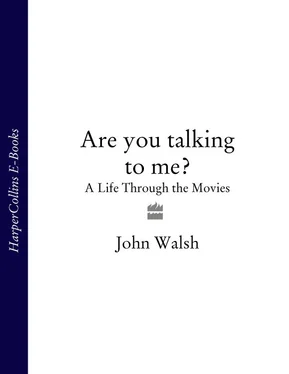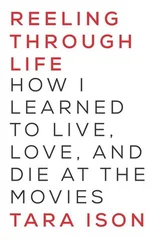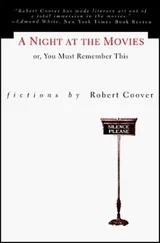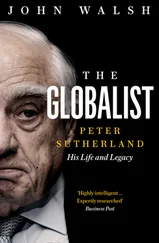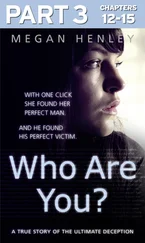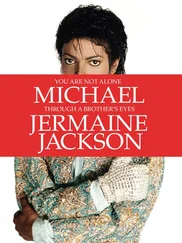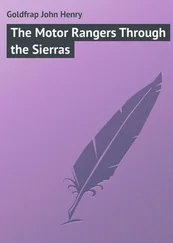A Life Through the Movies
JOHN WALSH

COPYRIGHT Copyright Dedication Introduction: Straining Your Eyes to See 1 The Cat in the Crimson Sock Mutiny on the Bounty (1962) 2 Faces at the Window The Innocents (1961) 3 John Wayne’s Filthy Temper Red River (1947) 4 Girl in the Gazebo The Sound of Music (1965) 5 White Hat and Golden Shirt Bonnie and Clyde (1967) 6 Dancing with Decadence Cabaret (1972) 7 Far Away from Everything The Enigma of Kaspar Hauser (1974) 8 After the Red Raincoat ‘Don’t Look Now’ (1973) Keep Reading Acknowledgements Further Reading About the Publisher
HarperCollins Publishers 1 London Bridge Street London SE1 9GF
www.harpercollins.co.uk
Published by HarperCollins Publishers 2003
Copyright © John Walsh 2003
The Author asserts the moral right to be identified as the author of this work
A catalogue record for this book is available from the British Library
All rights reserved under International and Pan-American Copyright Conventions. By payment of the required fees, you have been granted the nonexclusive, nontransferable right to access and read the text of this e-book on-screen. No part of this text may be reproduced, transmitted, downloaded, decompiled, reverse engineered, or stored in or introduced into any information storage and retrieval system, in any form or by any means, whether electronic or mechanical, now known or hereinafter invented, without the express written permission of HarperCollins e-books.
Source ISBN: 9780007139309
Ebook Edition © FEBRUARY 2013 ISBN 9780007441198
Version: 2016-03-23
Little Boxes Words and music by Malvina Reynolds © 1962 Schroder Music Co., (ASCAP) Renewed 1990 Used by permission. All rights reserved.
Jean Genie Words and music by David Bowie © 1973. Reproduced by permission of EMI Music Publishing Ltd/Moth Music; Chrysalis Music Ltd; and Tintorreto Music administered by RZO Music Inc for the USA and Canada and by RZO Music Ltd for the World excluding the USA and Canada.
There is Nothin’ Like a Dame Words Oscar Hammerstein II/music Richard Rodgers. © 1949 Williamson Music International. Reproduced by permission of EMI Music Publishing Ltd, London WC2H 0QY
Although we have tried to contact all copyright holders before publication, this has not been possible in every case. If notified, the publisher will be pleased to make any necessary arrangements to rectify errors and omissions at the earliest opportunity.
HarperCollinsPublishers has made every reasonable effort to ensure that any picture content and written content in this ebook has been included or removed in accordance with the contractual and technological constraints in operation at the time of publication.
DEDICATION Dedication Introduction: Straining Your Eyes to See 1 The Cat in the Crimson Sock Mutiny on the Bounty (1962) 2 Faces at the Window The Innocents (1961) 3 John Wayne’s Filthy Temper Red River (1947) 4 Girl in the Gazebo The Sound of Music (1965) 5 White Hat and Golden Shirt Bonnie and Clyde (1967) 6 Dancing with Decadence Cabaret (1972) 7 Far Away from Everything The Enigma of Kaspar Hauser (1974) 8 After the Red Raincoat ‘Don’t Look Now’ (1973) Keep Reading Acknowledgements Further Reading About the Publisher
This book is dedicated, with fond affection,
to Giles Brody – nephew, godson, film buff,
crazed Tarantino fan, precociously talented script-writer
and future movie director – hoping it will demonstrate that
you don’t have to be Samuel L. Jackson all the time …
Cover
Title Page ARE YOU TALKING TO ME? A Life Through the Movies JOHN WALSH
Copyright
Dedication
Introduction: Straining Your Eyes to See
1 The Cat in the Crimson Sock Mutiny on the Bounty (1962)
2 Faces at the Window The Innocents (1961)
3 John Wayne’s Filthy Temper Red River (1947)
4 Girl in the Gazebo The Sound of Music (1965)
5 White Hat and Golden Shirt Bonnie and Clyde (1967)
6 Dancing with Decadence Cabaret (1972)
7 Far Away from Everything The Enigma of Kaspar Hauser (1974)
8 After the Red Raincoat ‘Don’t Look Now’ (1973)
Keep Reading
Acknowledgements
Further Reading
About the Publisher
INTRODUCTION STRAINING YOUR EYES TO SEE
‘From the movies we learn precisely how to hold a champagne flute, kiss a mistress, pull a trigger, turn a phrase … but the movies spoil us for life: nothing ever lives up to them’
– Edmund White
You are sitting in the three-and-nine seats at the Granada cinema, Clapham Junction in 1962, with an empty carton of Kia-Ora crushed in your hand, and you are gazing into the horizon of a hazy, golden desert. Your eyes are straining to see what you think you see – what you might be able to see if you craned forward just a bit.
You are oblivious to the other people around you in this cut-price Alhambra Palace in south London. But even if you could register that 300 other people are sitting beside you, staring at the screen, you couldn’t believe they can see what you’re seeing. The experience you’re going through is wholly individual. Your eyes are – surely? – the only eyes capable of picking out the tiny dot on the horizon.
The film is David Lean’s Lawrence of Arabia. It’s not ideal entertainment for an eight-year-old. It’s full of men in military uniforms telling each other what’s what in the First World War, and talking about the Turks and a prince called Faisal. The hero is a pale, blue-eyed, extremely odd fellow called Lawrence whose party trick is to extinguish matches with his bare fingers without squealing with pain. He is cheeky to everyone, even to murderous-looking Arabs in black robes. He rides a camel like a ninny, though, stretching forward over the camel’s neck, waving a stick like someone trying to conduct an orchestra.
At this point in the film, he and fifty men in long skirts and head-shawls have crossed a huge desert called ‘The Sun’s Anvil’. Suddenly, Lawrence notices a riderless camel loping along the boiling sands, and decides they must go back for the fallen rider. The skirt-and-shawl brethren argue that the guy is probably dead by now, but Lawrence doesn’t listen. He sets off, bravely, suicidally, to rescue the man, while the others continue their journey to a nearby oasis. Watching them go is Lawrence’s young servant, who sticks around on the edge of the desert, waiting for his return. You are with him. You are waiting and watching beside him. Together you inspect the desert horizon, flat and shimmering and empty. The waiting servant, on the edge of nowhere, snoozes in the heat – but suddenly he is awake and alert, and can apparently see something. You look at the horizon again, flat and shimmering and – is that a fleck of something? What is he looking at? What are you looking at? Is that a tiny interruption in the hazy nothingness, a speck like a single grain of pepper in the soup of earth and sky? As you look at the horizon, you start to become the boy on the camel, you widen your eyes so they can see more clearly, willing the speck to become a man coming out of the desert, you sit forward in your seat as if bidding the seat to move. As the servant rides forward, picking up speed until the camel is racing along, your heart races alongside him, until you are running with him into the middle of nowhere, racing the kid to get there first, to see the unimaginable sight before he does.
Читать дальше
